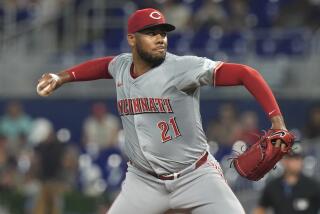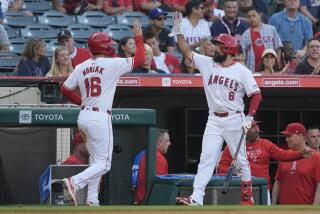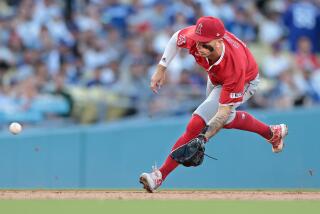Prospect Has Look of Veteran : Baseball: Everything Greene does makes the Angels happy that he is their catcher of the future.
- Share via
TEMPE, Ariz. — There is much to like about Todd Greene, the Angels’ catcher of the future--or, perhaps, the very near future.
He has bulging, Steve Garvey-esque forearms, steel pipe-like wrists and massive thighs, from where he derives the power and bat speed that helped him hit 40 home runs at double-A Midland and triple-A Vancouver last season.
He has what Angel player personnel director Bob Fontaine calls “fabulous mental makeup,” a combination of work ethic and desire that helped him flourish offensively despite making the difficult transition from outfield to catcher the past two seasons.
Oh, and another thing.
“He’s got the right hairline too,” General Manager Bill Bavasi said.
How’s that for a heady pair? Bavasi and Greene--two balding Angels, each with a healthy attitude toward his receding hairline, especially Greene, who has more reason to be self-conscious about his smooth pate, seeing as he’s only 24, and Bavasi is almost 38.
“I’ve got a pretty wife who loves me, what do I need hair for?” said Greene, who is playing in the Arizona Fall League. “Matt Williams is a pretty good hitter--he doesn’t have much hair. As long as I play in the big leagues, I don’t care about hair.”
And if Greene, who is a stocky yet sturdy 5 feet 9, 200 pounds, makes the big leagues and becomes a big star, don’t expect him to endorse any of those hair-replacement products or procedures.
“This is the way the Lord wanted me to be,” Greene said. “I don’t believe in all that fake stuff. I’m all natural. At least I’m easy to identify--if someone asked, ‘Who’s Todd Greene?’ he could just say, ‘He’s the bald kid over there.’ ”
When Greene was called up to replace the injured Greg Myers for the last three games of 1995, a few fans called him “Spike,” mistaking him for hairless infielder Spike Owen.
But the former Georgia Southern slugger, whose 88 collegiate homers from 1990-93 rank third on the NCAA’s all-time list, was pleasantly surprised by the number of fans who called him by name and had Todd Greene baseball cards for him to sign in Anaheim.
Then again, when you go from a questionable 12th-round pick in 1993--”I was a 5-9 power-hitter with an aluminum bat, an outfielder with average speed,” Greene says--to the organization’s top prospect and Baseball America’s minor league player of the year in a mere 2 1/2 seasons, fans tend to notice.
And when you hit 35 homers and knock in 124 runs at nearby Class-A Lake Elsinore in 1994 and follow that with a 40-homer season in ‘95; when you’re mentioned in virtually every significant Angel trade rumor because you’re the player other teams want, you develop some name recognition.
Angel fans, who have never, in 35 years, had a legitimate home-run hitting catcher to root for, are ready for Todd Greene, this long-ball hitting, block of granite they’ve heard so much about.
But is Greene ready for the Angels?
Offensively, yes, with some refinement. Once the line-drive hitter learns to stroke the ball the other way--batting instructor Rod Carew should be a big help here--the Angels project him as an above-average, major league hitter.
Defensively . . . Greene won’t lie.
“As far as receiving, blocking balls [in the dirt], throwing, I feel I can be an average catcher in the big leagues,” he said. “I’m certainly no Terry Steinbach or Ron Karkovice. The biggest thing I have to do is learn the pitchers and work on calling games.”
Bavasi doesn’t feel Greene is ready to be the Angels’ full-time catcher yet, as evidenced by his pursuit of free-agent catchers Benito Santiago and Joe Oliver this winter.
But if the Angels can’t add another catcher, it’s possible the right-handed hitting Greene will platoon next season with Myers, if the free agent is re-signed, or Jorge Fabregas, both left-handed hitters.
“I wouldn’t want to put that kind of pressure on him,” Bavasi said of the prospect of Greene as an everyday starter. “If he saw significant playing time, like three games a week, I’d keep him in Anaheim. Otherwise, I’d rather he be [playing every day] at triple-A.”
That’s no knock on Greene, though. Considering he never caught in youth baseball, high school or college and has spent only two full seasons behind the plate, Greene’s improvement has been stunning.
“He was in triple-A, catching only his second season, and no [scouts] said he did a bad job,” Fontaine said. “That’s progress.”
With growth came pain. Greene winces when he recalls his first minor league series as a catcher, in Bakersfield in 1994.
“I caught the first three games of the season and really thought I was going to die,” he said. “It was the most grueling thing I’ve ever experienced. I jammed my thumbs so many times I couldn’t feel my hands when I hit. I had eight passed balls in three games. It was a total disaster.”
Greene felt Lake Elsinore’s 5-25 start was largely because of his mistakes. He called his wife, Vanessa, in a bit of a panic. “I told her I didn’t know if I could do this,” Greene said.
Nonsense, said the Angels. They kept throwing him back there, and Greene kept making mistakes. He committed 15 errors and had 44 passed balls on the season. But most of those came in the first half.
Still, with the help of coaches such as Joe Maddon and John McNamara and teammate Jim Campanis, a veteran minor league catcher who provided numerous tips, Greene progressed so much in the second half he was voted the California League’s most improved player, an award he says he’s “most proud of,” even more than last season’s minor league player of the year trophy.
“I really credit the Angels, because they told me I’d make mistakes and I’d learn from them,” Greene said. “They kept encouraging me, kept their confidence in me, and they were always very positive. It was a pleasant learning experience with bad performance.”
Despite his defensive struggles, Greene hit .302 with a league-leading 35 homers, 39 doubles and 124 runs batted in. He hit a combined .300 with 40 homers and 92 RBIs last season and made great strides defensively, with only four errors and 14 passed balls.
He’s struggling a bit offensively in the Arizona Fall League, where he took a .224 average into the weekend, but the Angels aren’t concerned--they want him to concentrate on catching, not hitting.
“I can’t tell you how many times I’ve heard them say, ‘Don’t worry about your hitting,’ ” Greene said. “Everyone said catching would take away from my hitting, but I always had offense in the back of my mind. Learning to catch never really took away from my hitting, and I think that surprised the Angels.”
Well, not really.
“We know he can hit,” Bavasi said.
So does everyone else. Hardly a trade discussion has gone by in the past two years without mention of Greene, “but the more people asked about him, the tougher it became to trade him,” Bavasi said.
Now, Greene seems as untouchable as Tim Salmon or Gary DiSarcina, and if he isn’t behind the plate in Anaheim next season, “I expect him to be our catcher in 1997,” Bavasi said.
So don’t let that head fool you. Greene may be bald, but he’s the Angels’ fair-haired boy.
More to Read
Go beyond the scoreboard
Get the latest on L.A.'s teams in the daily Sports Report newsletter.
You may occasionally receive promotional content from the Los Angeles Times.







